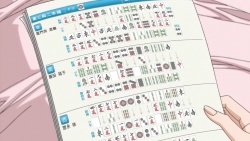Paifu: Difference between revisions
Jump to navigation
Jump to search
mNo edit summary |
No edit summary |
||
| Line 1: | Line 1: | ||
[[Image:Saki paifu.jpg|thumb|right|250px|Sample paifu from the animated series, [[Saki]].]] | [[Image:Saki paifu.jpg|thumb|right|250px|Sample paifu from the animated series, [[Saki]].]] | ||
'''Paifu''' {{kana|牌譜}} is a [[mahjong]] game record. In printed form, it lists the deal number, the names of the players, the result, and for each player, it lists the initial hand, the tiles taken and discarded in order, and the final hand. In most electronic mahjong games, the play is automatically recorded and may be "replayed" in a convenient manner. This makes it possible to view game replays and examine player's decision making. | '''Paifu''' {{kana|牌譜}} is a [[mahjong]] game record. In printed form, it lists the deal number, the names of the players, the result, and for each player, it lists the initial hand, the tiles taken and discarded in order, and the final hand. In most electronic mahjong games, the play is automatically recorded and may be "replayed" in a convenient manner. This makes it possible to view game replays and examine player's decision making. | ||
==Reading paifu== | |||
As a standard, paifu note the tiles in a hand during [[tile development]]. They are as follows: | |||
# [[Haipai]]. The players' opening hands are noted. | |||
# Next are the players' tile draws. | |||
# The third line shows discarded tiles. If a drawn tile is discarded, then a downward arrow is marked. | |||
# Finally, the end result of the hand is noted. This can either be the winning hand, the hand at ryuukyoku, or the state of the hand during another player's win. | |||
Also, any other player actions are noted such as [[Naki|tile calls]] and calls for [[riichi]]. | |||
== External links == | == External links == | ||
* [http://tenhou.net/6/ Tenhou.net paifu maker] | * [http://tenhou.net/6/ Tenhou.net paifu maker] | ||
* [https://www.google.com/search?site=&tbm=isch&source=hp&biw=1280&bih=827&q=%E7%89%8C%E8%AD%9C&oq=%E7%89%8C%E8%AD%9C&gs_l=img.3...1295.2799.0.2871.9.7.0.2.0.0.177.791.3j4.7.0....0...1ac.1j4.37.img..7.2.208.duxRIFtdYCI Google image search for 牌譜] | * [https://www.google.com/search?site=&tbm=isch&source=hp&biw=1280&bih=827&q=%E7%89%8C%E8%AD%9C&oq=%E7%89%8C%E8%AD%9C&gs_l=img.3...1295.2799.0.2871.9.7.0.2.0.0.177.791.3j4.7.0....0...1ac.1j4.37.img..7.2.208.duxRIFtdYCI Google image search for 牌譜] | ||
Revision as of 11:01, 26 January 2015

Paifu 「牌譜」 is a mahjong game record. In printed form, it lists the deal number, the names of the players, the result, and for each player, it lists the initial hand, the tiles taken and discarded in order, and the final hand. In most electronic mahjong games, the play is automatically recorded and may be "replayed" in a convenient manner. This makes it possible to view game replays and examine player's decision making.
Reading paifu
As a standard, paifu note the tiles in a hand during tile development. They are as follows:
- Haipai. The players' opening hands are noted.
- Next are the players' tile draws.
- The third line shows discarded tiles. If a drawn tile is discarded, then a downward arrow is marked.
- Finally, the end result of the hand is noted. This can either be the winning hand, the hand at ryuukyoku, or the state of the hand during another player's win.
Also, any other player actions are noted such as tile calls and calls for riichi.